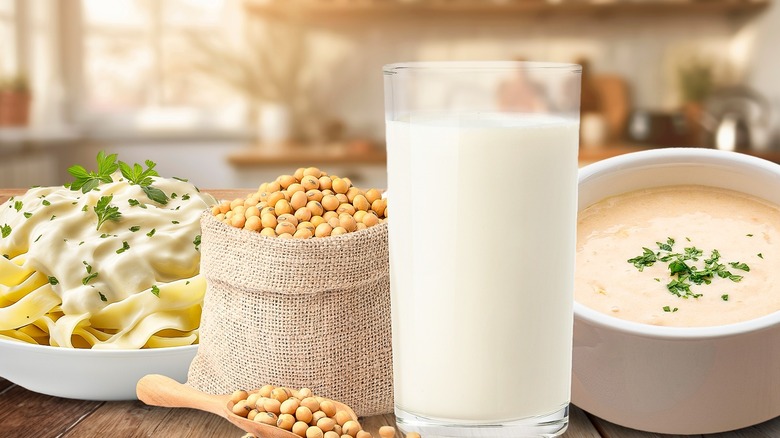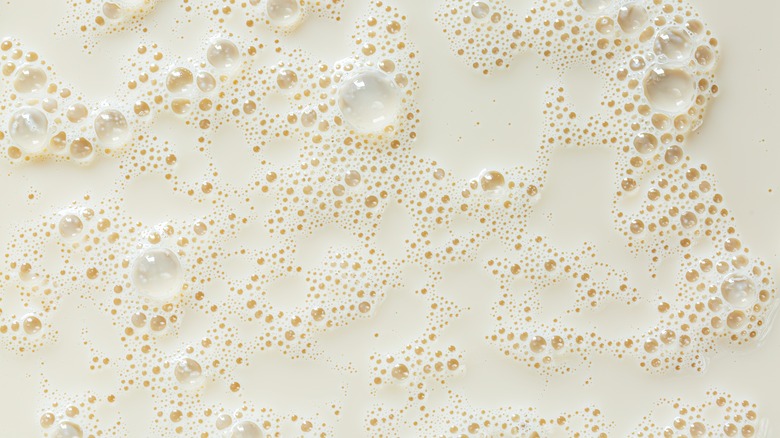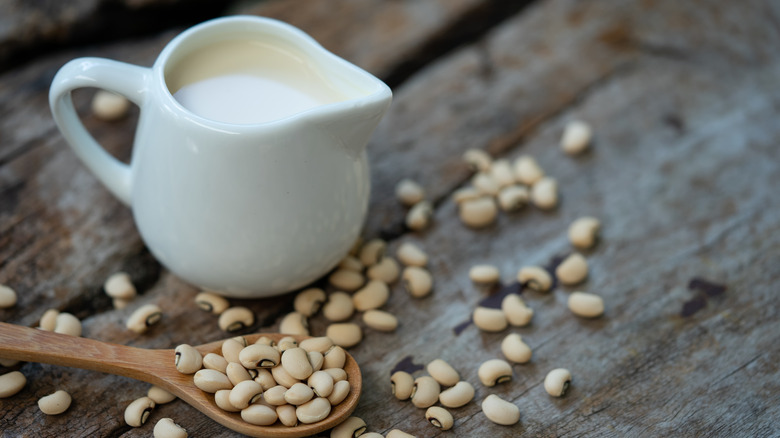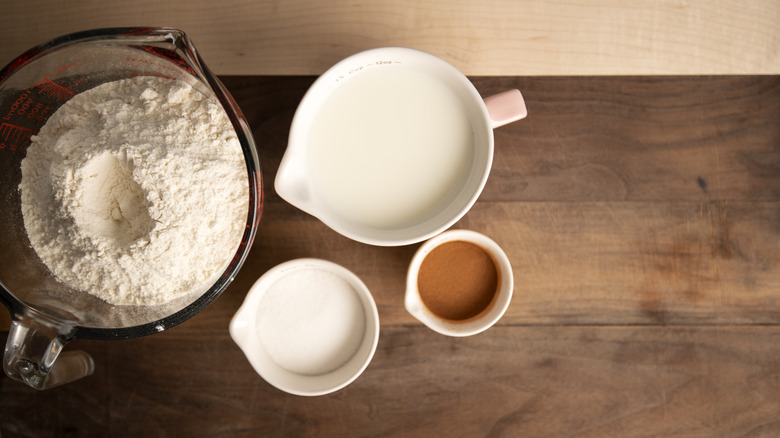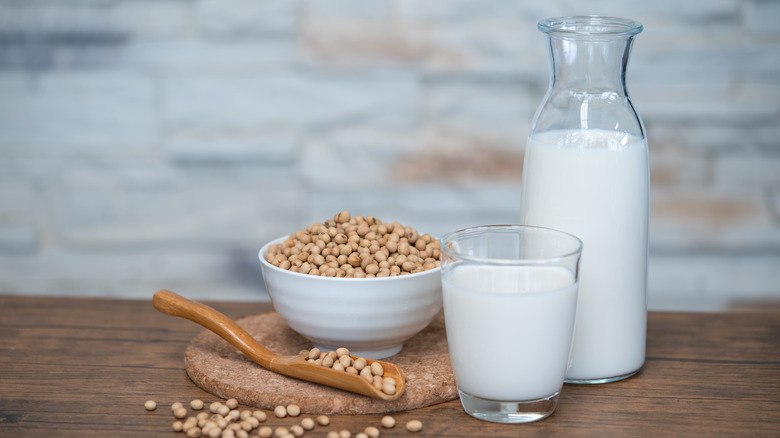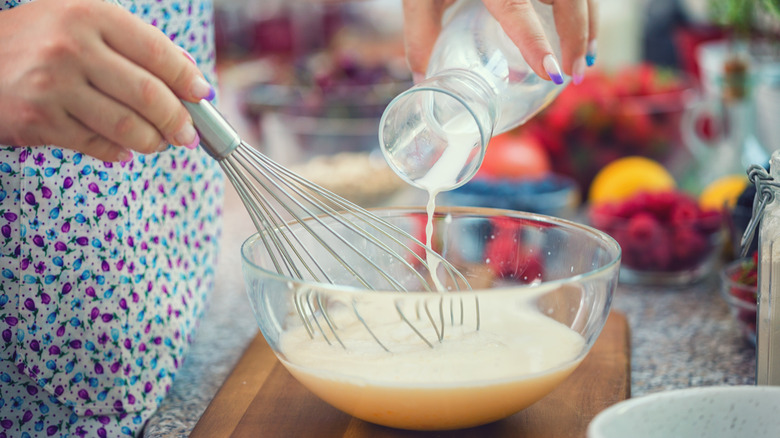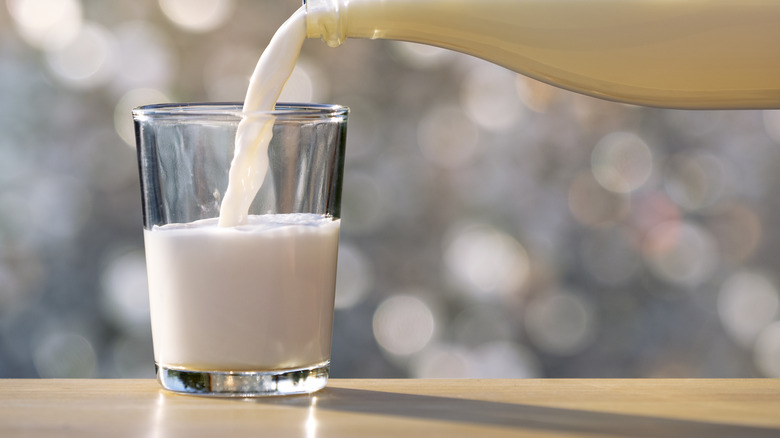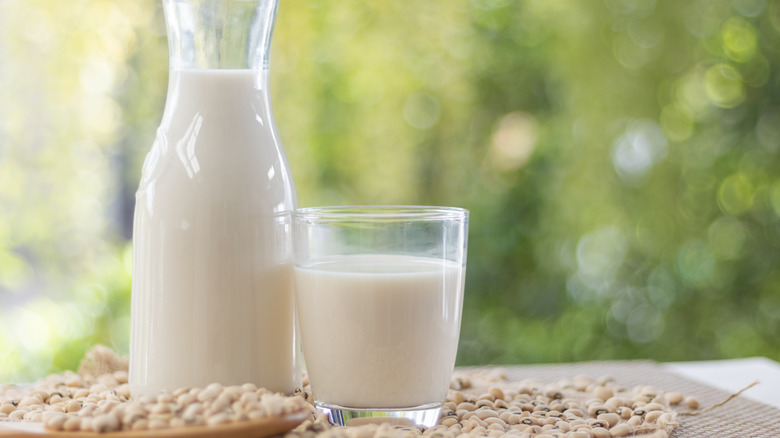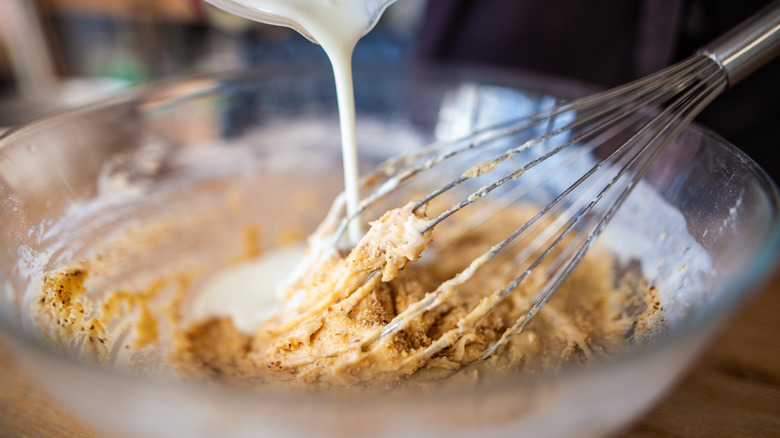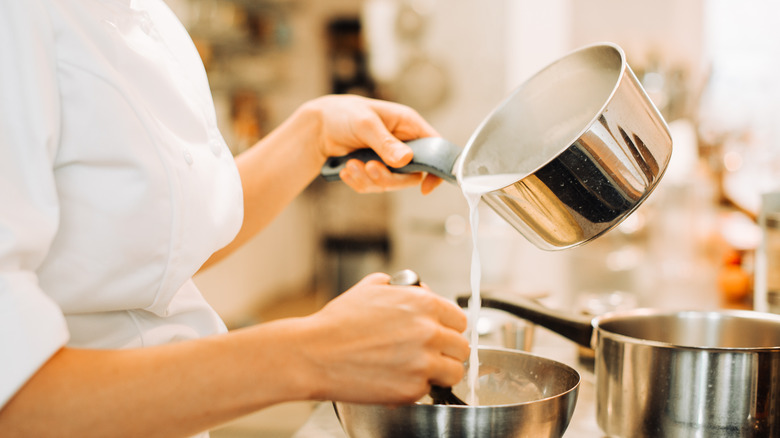The Biggest Mistakes You're Making Cooking With Soy Milk
Soy milk is an absolutely fantastic replacement for dairy milk. It's versatile, it's easy to use, and it's a highly accessible choice for an alternative milk – it can be found everywhere from your local coffee shop to grocery store aisles. This makes many nondairy cooks dub soy milk the best milk substitute for cooking. But, just like when you're working with any new-to-you substitution, it can take a little bit of getting used to when it comes to using it in your cooking. For many people, this involves a lot of trial and error. But if you're looking to speed up the learning process, there are a few things you absolutely need to know.
As someone who has been baking and cooking with plant-based dairy substitutes for about a decade, I've been through the highs and lows of nondairy foods — from having to rely on a single brand of nondairy milk to seeing aisles fill up with endless choices of nondairy brands. I've also made my fair share of mistakes when cooking with nondairy milk. It's not exactly difficult, but it can be very different from cooking with dairy milk. These are the most common mistakes I see people make (and yes, I've made them myself, too) when they're cooking (and even baking) with soy milk.
Using the wrong brand of soy milk
When you're cooking with soy milk, some brands of soy milk will work better than others. That's because each company has a different production process, and some brands choose to really water down their soy milk. This makes the soy milk less rich and creamy, which means that if you opt for these kinds of brands, the consistency of your recipe might change more significantly when compared to its original dairy version.
Especially if you're making something that heavily relies on dairy milk for its flavor and texture — think creamy pastas, rich baked goods, heavy soups, or even smoothies — you want to avoid using a nondairy product that is extremely watery. Keep in mind that a good soy milk brand will still have water listed as the top ingredient — it is a key factor in the soy milk production process, after all — but it will be rich and cream-colored. Another way to confirm you're picking out a good brand of soy milk is to check the brand's ingredients to see if it goes heavy on preservatives or not — doing so can sometimes be a bad sign when it comes to quality soy milk.
Lastly, if you're trying out a new brand, note what it looks like when you pour it out. Is it watery? Not rich in color? Bland? Try a different brand.
Ignoring soy milk variations when cooking
When you're working with soy milk, you should know that there are some kinds of soy milk that are designed to replace specific kinds of milk. The most important example here is always going to be products like dairy heavy cream. If you replace heavy cream with regular soy milk — especially for dishes like ultra-creamy pastas and soups — you're going to fundamentally change the recipe, and not in a good way. You really want something with the same thickness, richness, and consistency of heavy cream when a recipe calls for it.
To combat this issue, you should look for a brand of soy milk with a carton that specifies what its use is. When you want regular soy milk, just look for a carton that says "soy milk." But when you need a good substitute for heavy cream, you should opt for a soy milk carton that specifies it can be used as a heavy cream substitute.
Keep in mind that this substitution problem also works the other way around. If you try to use soy heavy cream for a dish that calls for regular milk, you'll definitely regret it.
This substitution method holds true for many different kinds of soy milk products, from specific soy coffee creamers to soy barista milks and everything in between. Generally, plain soy milk will work just fine for most recipes, though.
Not using a 1:1 substitution ratio
Nondairy milks generally use a 1:1 replacement ratio when it comes to dairy alternatives. This is because nondairy brands want to make nondairy milk as easy to use (and as accessible) as dairy milk — no odd conversions or mathematic equations required. The same is true when it comes to soy milk. Use a 1:1 soy milk replacement ratio across all of your recipes, whether you're cooking or baking.
You can confirm this replacement ratio with the specific brand you're working with by checking on the soy milk carton (or even on the brand's official website). The carton will also sometimes have additional tips or recipes you can test its soy milk in.
Using sweetened soy milk
When you're shopping for soy milk, you're likely to notice a lot of sweetened soy milks. This can actually be relatively easy to miss on the packaging, because unlike with dairy milks, sweetened nondairy milks are sometimes even more common in grocery store aisles than their unsweetened counterparts. Many brands will also use nearly identical packaging for their sweetened and unsweetened soy milk. I've certainly accidentally mixed the two up and ended up with a bag full of sweetened nondairy milk once or twice.
Sweetened soy milk is great if you're planning on making a latte or smoothie, but not so much if you're cooking up an actual meal. The taste of sweetened soy milk is more like a barista milk – sweet enough to drink on its own. It will also sometimes be flavored, even if that's not apparent on the packaging — vanilla is one common flavor addition you're likely to spot when purchasing soy milk.
Even if you're baking something sweet, you'll want to use unsweetened soy milk, or else you risk throwing off the sugar ratio. Recipes that are formulated with dairy milk won't taste the same if you use sweetened soy milk as a substitute. Plain, unsweetened soy milk is the most similar to dairy milk taste-wise and won't throw off the flavor of the dish. Be sure to double-check the soy milk you're buying to make sure it's not sweetened or otherwise flavored.
Using plain soy milk to replace buttermilk
For those who don't want to clog up their fridges with extra cartons of specific-use soy milk, you're in luck. Regular soy milk can be used to replace buttermilk — but only if you add one extra ingredient to it first. If you're planning on using soy milk instead of buttermilk in a recipe, you should add a little bit of apple cider vinegar to the soy milk and allow the mixture to sit for at least five minutes.
You might have heard of this trick already if you've been busy baking with dairy milks before — and it works just the same for soy milk, too. You'll want to use a ratio of about 1 tablespoon of apple cider vinegar per 1 cup of soy milk. Add all the soy milk you'll be using to a bowl, put in the apple cider vinegar, mix them together, and leave it alone for a few minutes (uncovered and out of the fridge is fine). If you don't have apple cider vinegar, you can also use lemon juice.
When the mixture is ready, you should notice that the soy milk will have curdled slightly. This changes the texture and flavor of the milk to mimic buttermilk exactly. It makes the perfect buttermilk copycat for any recipe, and better yet, you don't need to head to the supermarket for a buttermilk-specific soy milk replacement.
Burning your soy milk accidentally
The temperature at which dairy milk burns can vary depending on its fat content. If you're used to cooking with dairy milk and are switching to soy (or even if you're trying to froth up some nondairy milk for your morning drink), you might accidentally burn the soy milk. This will ruin the flavor of the milk and make the rest of your dish taste burnt or even bitter.
You should only heat soy milk to around 140 degrees Fahrenheit as a good baseline, although lower is generally better. Of course, this isn't true when mixing soy milk into things such as baked goods. You'll also probably note that this means soy milk generally won't be boiled. It is typically a good rule of thumb — especially for beginners — to keep soy milk within lower temperatures because it is much easier to burn than dairy milks (and other nondairy milks). Some nondairy enthusiasts swear by never, ever boiling soy milk.
Some like to boil it but stir it consistently to prevent it from burning. If you're heating it in the microwave, take it out every so often (every 30 seconds to every minute) to stir it, which will help prevent burning or curdling. If you're heating it over the stove, stir it regularly.
Trying to nail an all-white dish
This is an interesting note to consider if you're a baker or just someone who loves cake decorating. When you're making frosting with soy milk, it will not be pure white. Most people expect soy milk to be an exact replacement for milk when it comes to frostings. I find that it certainly tastes the same — and even acts the same in terms of thickness and stability — but soy milk is just not pure white like dairy milk. It's cream-colored.
Now, you can dye your frostings white, and this is a great option for someone who's making a soy-milk-based frosting, but this is still an important thing to plan ahead for if you're a home baker who wants to ace decorating your baked goods. This is even true if you're wondering why white sauces (like for pastas and pizzas) are coming out more cream-colored than usual. Keep in mind that soy milk being cream-colored will not affect the flavor of your dishes; it's just something to keep in mind if you're worried about the color.
If you truly are concerned about trying to get your frosting to be pure white (hello, wedding cakes), you should either opt for a white food dye or just not use soy milk. Try something like coconut milk instead to achieve a pure white color without the dye.
Adding your soy milk to hot liquids
It might surprise you to know that nondairy milks can curdle in the same situations that dairy milk does. One way you might accidentally curdle your soy milk is by adding it directly to hot liquids while you're cooking. If you do end up curdling your soy milk, it will still be edible, but it can seriously change the texture of the dish you're making — and might completely ruin the flavor and consistency of your dish, too.
To stay on the safe side, it's best to heat soy milk slowly and avoid adding it directly to hot liquids. You can either turn down the heat on whatever you're cooking before you add the soy milk or add soy milk to your dish before you start heating it. When you are heating the soy milk, make sure to do it slowly to prevent it from curdling. Rapid changes in temperature will cause the soy milk to curdle even if you're not adding it directly to anything — although the latter situation is usually where most people run into trouble when it comes to cooking with soy milk.
Making your dishes less rich because of soy milk
Soy milk makes a fantastic replacement for regular milk, but every once in a while, it can fall a little short. If you're attempting to make a dish or baked goods that are extremely rich, you might find that your regular soy milk isn't cutting it. Not everyone is going to encounter this problem — honestly, it's rare to find a dish that plain soy milk isn't suitable for. But if you're someone who really wants to nail the extra creaminess, especially in a dish that doesn't call for cream, you might want to try adding more of the other ingredients that will help that.
Depending on what you're making, you might try adding things like extra nondairy cheese, more plant-based butter, or even a little bit of nondairy cream to thicken up the soy milk you're adding. This can help thicken the dish and make it richer.
If you're new to working with soy milk, I would highly recommend trying all your favorite recipes with plain soy milk first before deciding whether or not you need to make it richer. Most people will start by assuming that soy milk isn't enough on its own, which can cause them to add in too many extras or start trying substitutions that just end up making the dish taste bad.
Not adding ingredients to help thicken your dish
Generally, many soy milk brands are thinner than dairy milks, especially if you're used to the richness of dairy milk. You might find that you need to occasionally thicken the dishes you're working with. Keep in mind that this is different than making the flavor of the dish richer — this is about thickness only.
If you want to make a thicker sauce, adding a little bit of flour is the easiest way to thicken up soy milk for pastas, soups, and other sauces. Start with a small sprinkle of flour, mix it thoroughly into your dish, and wait a bit to see if the sauce thickens to your liking. You can then continue to add more flour until the sauce is as thick as you want it to be.
Adding flour won't affect the end flavor or texture of your dish — just make sure that you add the flour while you're still cooking so that it can cook completely along with the rest of your dish. As an added bonus, this hack also works with gluten-free flour.
You can also try adding other creamy ingredients like plant-based cheeses, plant-based unflavored yogurt, or nutritional yeast to thicken up your dishes. Doing this can change the flavor slightly, but it might just be worth it for a thicker sauce.
Trying to mask the taste of soy milk in cooking
I commonly run into a lot of people who are concerned about the taste of soy milk potentially affecting their cooking. This is probably because plain soy milk is, well ... definitely an acquired taste. Especially for someone who is used to milk not having a certain flavor (or used to other nondairy milks that taste "better" plain, like coconut milk), soy milk can taste very strong — and it's not necessarily a flavor that you'd want to taste in most dishes. This causes some home chefs to try to add in extra ingredients, use less soy milk than the recipe calls for, or cut their soy milk with water (or other flavors) to try and mask the taste.
This is unnecessary when you're cooking with soy milk. Soy milk has absolutely no taste when used in baked goods or for cooking. If you're trying it plain (or maybe in your morning coffee), you might not enjoy it. But there's absolutely no need to add extra ingredients or cut the amount of soy milk you're using when you're cooking or baking — the taste is just not strong enough to come through in any dish, even if you're not using many ingredients or spices. Use the full amount of soy milk the recipe calls for, don't worry about the flavor, and prepare to be amazed that the taste of soy milk is not apparent whatsoever in your meal.
